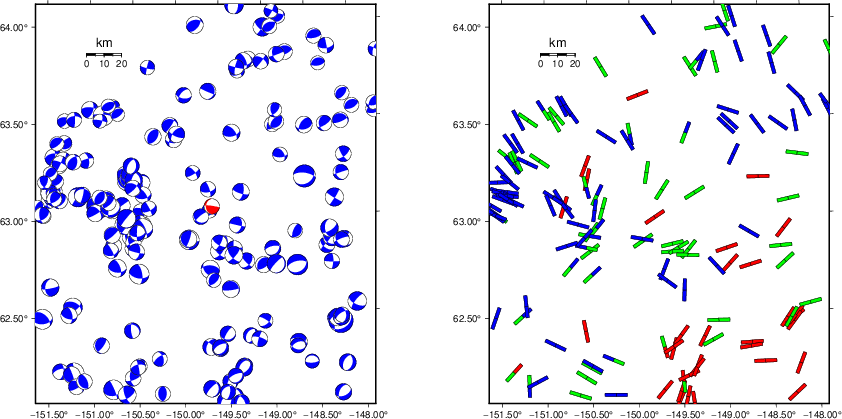Location
Location ANSS
The ANSS event ID is ak0257rkwpqb and the event page is at
https://earthquake.usgs.gov/earthquakes/eventpage/ak0257rkwpqb/executive.
2025/06/18 05:18:17 63.063 -149.646 87.5 3.8 Alaska
Focal Mechanism
USGS/SLU Moment Tensor Solution
ENS 2025/06/18 05:18:17.0 63.06 -149.65 87.5 3.8 Alaska
Stations used:
AK.BPAW AK.CAST AK.CCB AK.DHY AK.GHO AK.H23K AK.HDA AK.J20K
AK.K24K AK.KNK AK.MCK AK.PAX AK.POKR AK.PPLA AK.RND AK.SAW
AK.SCM AK.SKN AK.WRH AT.PMR IM.IL31 IU.COLA
Filtering commands used:
cut o DIST/3.5 -40 o DIST/3.5 +50
rtr
taper w 0.1
hp c 0.03 n 3
lp c 0.08 n 3
Best Fitting Double Couple
Mo = 7.24e+21 dyne-cm
Mw = 3.84
Z = 96 km
Plane Strike Dip Rake
NP1 280 85 65
NP2 179 25 168
Principal Axes:
Axis Value Plunge Azimuth
T 7.24e+21 44 165
N 0.00e+00 25 282
P -7.24e+21 35 31
Moment Tensor: (dyne-cm)
Component Value
Mxx -6.26e+19
Mxy -3.06e+21
Mxz -6.41e+21
Myy -1.08e+21
Myz -8.60e+20
Mzz 1.14e+21
###-----------
####------------------
#####-----------------------
####----------------- ------
#####------------------ P --------
#####------------------- ---------
#####---------------------------------
#####-----------------------------------
#####-----------------------------------
-----######-------------------------------
-----##################-------------------
-----###########################----------
------#################################---
-----###################################
-----###################################
-----############### ###############
-----############## T ##############
-----############# #############
----##########################
-----#######################
----##################
---###########
Global CMT Convention Moment Tensor:
R T P
1.14e+21 -6.41e+21 8.60e+20
-6.41e+21 -6.26e+19 3.06e+21
8.60e+20 3.06e+21 -1.08e+21
Details of the solution is found at
http://www.eas.slu.edu/eqc/eqc_mt/MECH.NA/20250618051817/index.html
|
Preferred Solution
The preferred solution from an analysis of the surface-wave spectral amplitude radiation pattern, waveform inversion or first motion observations is
STK = 280
DIP = 85
RAKE = 65
MW = 3.84
HS = 96.0
The NDK file is 20250618051817.ndk
The waveform inversion is preferred.
Magnitudes
Given the availability of digital waveforms for determination of the moment tensor, this section documents the added processing leading to mLg, if appropriate to the region, and ML by application of the respective IASPEI formulae. As a research study, the linear distance term of the IASPEI formula
for ML is adjusted to remove a linear distance trend in residuals to give a regionally defined ML. The defined ML uses horizontal component recordings, but the same procedure is applied to the vertical components since there may be some interest in vertical component ground motions. Residual plots versus distance may indicate interesting features of ground motion scaling in some distance ranges. A residual plot of the regionalized magnitude is given as a function of distance and azimuth, since data sets may transcend different wave propagation provinces.
ML Magnitude

Left: ML computed using the IASPEI formula for Horizontal components. Center: ML residuals computed using a modified IASPEI formula that accounts for path specific attenuation; the values used for the trimmed mean are indicated. The ML relation used for each figure is given at the bottom of each plot.
Right: Residuals from new relation as a function of distance and azimuth.

Left: ML computed using the IASPEI formula for Vertical components (research). Center: ML residuals computed using a modified IASPEI formula that accounts for path specific attenuation; the values used for the trimmed mean are indicated. The ML relation used for each figure is given at the bottom of each plot.
Right: Residuals from new relation as a function of distance and azimuth.
Context
The left panel of the next figure presents the focal mechanism for this earthquake (red) in the context of other nearby events (blue) in the SLU Moment Tensor Catalog. The right panel shows the inferred direction of maximum compressive stress and the type of faulting (green is strike-slip, red is normal, blue is thrust; oblique is shown by a combination of colors). Thus context plot is useful for assessing the appropriateness of the moment tensor of this event.
Waveform Inversion using wvfgrd96
The focal mechanism was determined using broadband seismic waveforms. The location of the event (star) and the
stations used for (red) the waveform inversion are shown in the next figure.
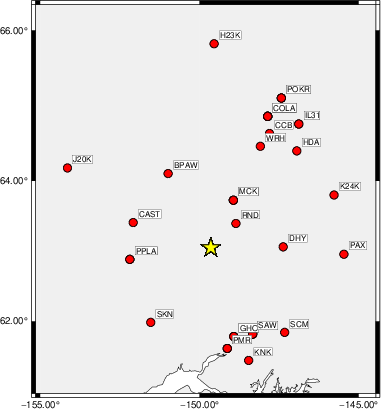
|
|
Location of broadband stations used for waveform inversion
|
The program wvfgrd96 was used with good traces observed at short distance to determine the focal mechanism, depth and seismic moment. This technique requires a high quality signal and well determined velocity model for the Green's functions. To the extent that these are the quality data, this type of mechanism should be preferred over the radiation pattern technique which requires the separate step of defining the pressure and tension quadrants and the correct strike.
The observed and predicted traces are filtered using the following gsac commands:
cut o DIST/3.5 -40 o DIST/3.5 +50
rtr
taper w 0.1
hp c 0.03 n 3
lp c 0.08 n 3
The results of this grid search are as follow:
DEPTH STK DIP RAKE MW FIT
WVFGRD96 2.0 50 45 95 3.05 0.2250
WVFGRD96 4.0 0 75 -10 2.99 0.2471
WVFGRD96 6.0 0 60 10 3.06 0.2710
WVFGRD96 8.0 0 60 5 3.13 0.2912
WVFGRD96 10.0 -5 60 -15 3.18 0.3059
WVFGRD96 12.0 -5 65 -15 3.21 0.3122
WVFGRD96 14.0 -5 65 -10 3.23 0.3118
WVFGRD96 16.0 270 80 -15 3.26 0.3131
WVFGRD96 18.0 270 75 -15 3.29 0.3232
WVFGRD96 20.0 270 75 -15 3.32 0.3317
WVFGRD96 22.0 270 75 -15 3.34 0.3391
WVFGRD96 24.0 270 75 -20 3.36 0.3463
WVFGRD96 26.0 270 75 -20 3.38 0.3533
WVFGRD96 28.0 265 70 -20 3.41 0.3592
WVFGRD96 30.0 265 70 -20 3.43 0.3656
WVFGRD96 32.0 265 70 -20 3.45 0.3700
WVFGRD96 34.0 265 70 -20 3.47 0.3754
WVFGRD96 36.0 265 70 -15 3.49 0.3783
WVFGRD96 38.0 270 75 -10 3.52 0.3829
WVFGRD96 40.0 270 80 -15 3.57 0.3916
WVFGRD96 42.0 270 80 -15 3.59 0.3860
WVFGRD96 44.0 90 90 20 3.61 0.3808
WVFGRD96 46.0 80 70 -35 3.67 0.3862
WVFGRD96 48.0 85 75 -35 3.68 0.4017
WVFGRD96 50.0 80 75 -40 3.71 0.4202
WVFGRD96 52.0 80 75 -40 3.72 0.4440
WVFGRD96 54.0 85 80 -40 3.72 0.4675
WVFGRD96 56.0 85 80 -40 3.73 0.4892
WVFGRD96 58.0 85 80 -40 3.75 0.5085
WVFGRD96 60.0 85 80 -40 3.75 0.5264
WVFGRD96 62.0 85 80 -40 3.76 0.5415
WVFGRD96 64.0 85 80 -45 3.77 0.5546
WVFGRD96 66.0 85 85 -45 3.77 0.5658
WVFGRD96 68.0 85 85 -45 3.78 0.5785
WVFGRD96 70.0 85 85 -50 3.79 0.5891
WVFGRD96 72.0 270 90 50 3.78 0.5978
WVFGRD96 74.0 270 90 50 3.79 0.6073
WVFGRD96 76.0 90 90 -55 3.80 0.6158
WVFGRD96 78.0 90 90 -55 3.80 0.6227
WVFGRD96 80.0 90 90 -55 3.81 0.6295
WVFGRD96 82.0 275 85 60 3.81 0.6373
WVFGRD96 84.0 275 85 60 3.81 0.6413
WVFGRD96 86.0 90 90 -55 3.81 0.6396
WVFGRD96 88.0 275 85 60 3.82 0.6491
WVFGRD96 90.0 275 85 60 3.82 0.6504
WVFGRD96 92.0 280 85 65 3.84 0.6510
WVFGRD96 94.0 280 85 65 3.84 0.6515
WVFGRD96 96.0 280 85 65 3.84 0.6516
WVFGRD96 98.0 280 85 65 3.85 0.6507
WVFGRD96 100.0 280 85 65 3.85 0.6491
WVFGRD96 102.0 280 85 65 3.85 0.6462
WVFGRD96 104.0 280 85 65 3.85 0.6430
WVFGRD96 106.0 285 80 65 3.85 0.6394
WVFGRD96 108.0 285 80 65 3.85 0.6351
WVFGRD96 110.0 285 80 65 3.85 0.6313
WVFGRD96 112.0 280 80 65 3.85 0.6266
WVFGRD96 114.0 280 80 65 3.85 0.6211
WVFGRD96 116.0 280 80 60 3.85 0.6162
WVFGRD96 118.0 280 80 60 3.85 0.6109
The best solution is
WVFGRD96 96.0 280 85 65 3.84 0.6516
The mechanism corresponding to the best fit is
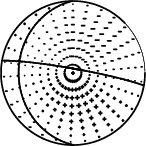
|
|
Figure 1. Waveform inversion focal mechanism
|
The best fit as a function of depth is given in the following figure:
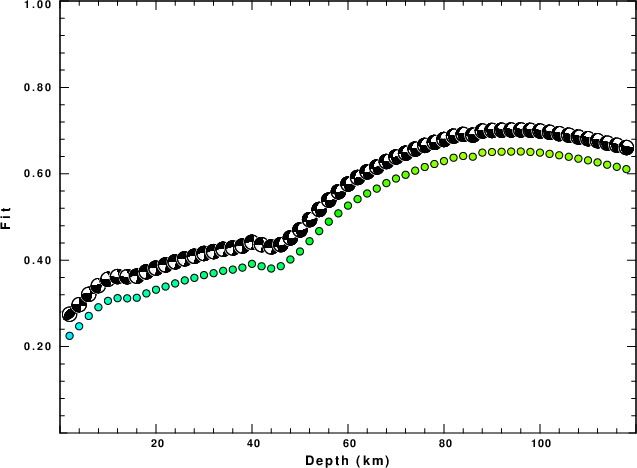
|
|
Figure 2. Depth sensitivity for waveform mechanism
|
The comparison of the observed and predicted waveforms is given in the next figure. The red traces are the observed and the blue are the predicted.
Each observed-predicted component is plotted to the same scale and peak amplitudes are indicated by the numbers to the left of each trace. A pair of numbers is given in black at the right of each predicted traces. The upper number it the time shift required for maximum correlation between the observed and predicted traces. This time shift is required because the synthetics are not computed at exactly the same distance as the observed, the velocity model used in the predictions may not be perfect and the epicentral parameters may be be off.
A positive time shift indicates that the prediction is too fast and should be delayed to match the observed trace (shift to the right in this figure). A negative value indicates that the prediction is too slow. The lower number gives the percentage of variance reduction to characterize the individual goodness of fit (100% indicates a perfect fit).
The bandpass filter used in the processing and for the display was
cut o DIST/3.5 -40 o DIST/3.5 +50
rtr
taper w 0.1
hp c 0.03 n 3
lp c 0.08 n 3
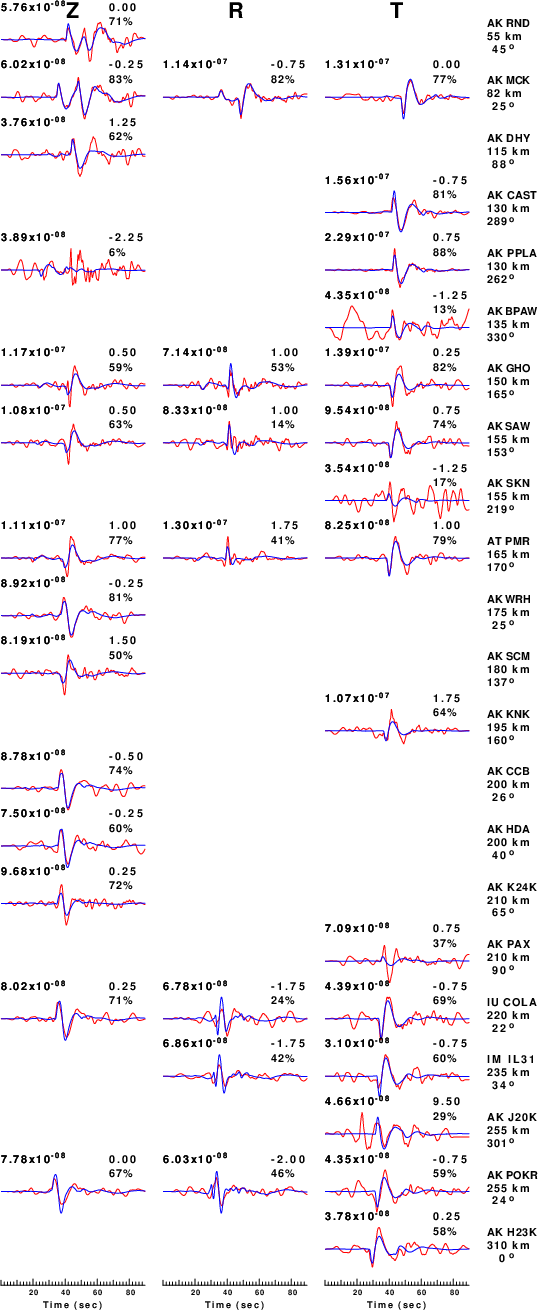
|
|
Figure 3. Waveform comparison for selected depth. Red: observed; Blue - predicted. The time shift with respect to the model prediction is indicated. The percent of fit is also indicated. The time scale is relative to the first trace sample.
|
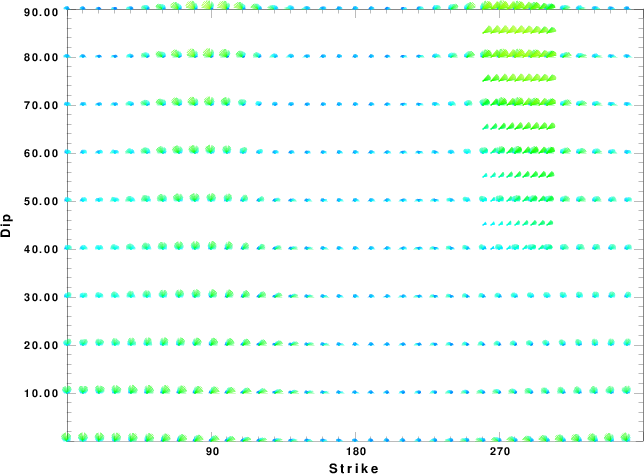
|
|
Focal mechanism sensitivity at the preferred depth. The red color indicates a very good fit to the waveforms.
Each solution is plotted as a vector at a given value of strike and dip with the angle of the vector representing the rake angle, measured, with respect to the upward vertical (N) in the figure.
|
A check on the assumed source location is possible by looking at the time shifts between the observed and predicted traces. The time shifts for waveform matching arise for several reasons:
- The origin time and epicentral distance are incorrect
- The velocity model used for the inversion is incorrect
- The velocity model used to define the P-arrival time is not the
same as the velocity model used for the waveform inversion
(assuming that the initial trace alignment is based on the
P arrival time)
Assuming only a mislocation, the time shifts are fit to a functional form:
Time_shift = A + B cos Azimuth + C Sin Azimuth
The time shifts for this inversion lead to the next figure:
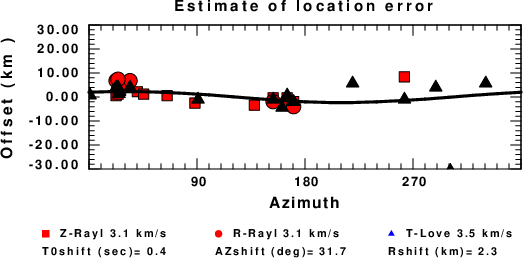
The derived shift in origin time and epicentral coordinates are given at the bottom of the figure.
Velocity Model
The WUS.model used for the waveform synthetic seismograms and for the surface wave eigenfunctions and dispersion is as follows
(The format is in the model96 format of Computer Programs in Seismology).
MODEL.01
Model after 8 iterations
ISOTROPIC
KGS
FLAT EARTH
1-D
CONSTANT VELOCITY
LINE08
LINE09
LINE10
LINE11
H(KM) VP(KM/S) VS(KM/S) RHO(GM/CC) QP QS ETAP ETAS FREFP FREFS
1.9000 3.4065 2.0089 2.2150 0.302E-02 0.679E-02 0.00 0.00 1.00 1.00
6.1000 5.5445 3.2953 2.6089 0.349E-02 0.784E-02 0.00 0.00 1.00 1.00
13.0000 6.2708 3.7396 2.7812 0.212E-02 0.476E-02 0.00 0.00 1.00 1.00
19.0000 6.4075 3.7680 2.8223 0.111E-02 0.249E-02 0.00 0.00 1.00 1.00
0.0000 7.9000 4.6200 3.2760 0.164E-10 0.370E-10 0.00 0.00 1.00 1.00
Last Changed Wed Jun 18 07:26:04 EDT 2025


